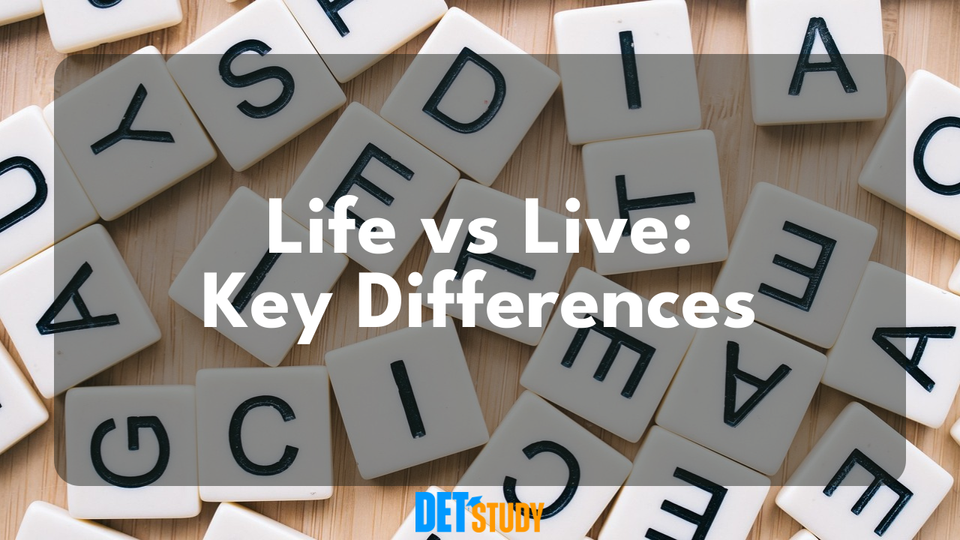Life vs Live: Understanding Their Differences and Common Language Mistakes

When learning English, it's crucial to distinguish between words that sound similar but have different meanings and uses. Two such words are "life" and "live." Understanding their differences can help you use them correctly in both writing and conversation.
Life
-
Definition: "Life" is a noun. It refers to the existence of an individual human, animal, or any living organism. It can also refer to the period during which something functions or exists.
-
Examples: - Human Life: "She dedicated her life to helping others." - Animal Life: "Marine life is affected by ocean pollution." - Figurative Use: "The life of the party is usually someone who keeps everyone entertained."
-
Usage Tips: - Think of "life" as the state of being alive or the essence of living things. - Remember that "life" is often used to discuss existence, experiences, and vitality.
Live
- Verb Definition: As a verb, "live" refers to the act of being alive, continuing existence, or residing in a particular place.
- Example: "They live in a beautiful cottage by the sea."
- Context: Used to express ongoing life or action ("How long can we live without water?").
- Adjective Definition: As an adjective, "live" describes something that is happening now, not recorded or on a delay.
- Example: "We watched a live football match."
- Context: Used to describe performances or broadcasts happening in real-time ("This is a live broadcast from New York").
- Usage Tips: - As a verb, "live" will often be seen in phrases like "to live happily" or "live your best life." - As an adjective, "live" is used to differentiate between real-time events and those that are recorded.
By understanding these key differences, you'll be better equipped to use "life" and "live" accurately in various contexts and improve your English communication skills.
English learners often confuse "life" and "live" because these words look similar but have different uses and meanings. Here are some common mistakes and tips on how to avoid them:
Mistake #1: Confusing Noun and Verb Forms
Life is a noun, and it refers to the existence of an individual or the state of being alive.
Live can be a verb, meaning to remain alive or reside in a particular place. It can also be an adjective, describing something happening in real-time, like a live broadcast.
- Incorrect: She has a happy live.
- Correct: She has a happy life.
Tip: Use "life" when you are talking about the noun form related to being alive or existence.
Mistake #2: Mispronouncing "Live" as a Noun
When used as a noun, "life" is often mistakenly pronounced like "live" as in the verb form.
- Incorrect: Life (pronounced like "give") is precious.
- Correct Pronunciation: Life (pronounced like "knife") is precious.
Tip: Remember that "life" rhymes with "knife."
Mistake #3: Incorrect Verb Tense Usage
Sometimes "live" is used incorrectly when trying to convey actions.
- Incorrect: They life in New York.
- Correct: They live in New York.
Tip: Use "live" when referring to the verb meaning of dwelling or residing somewhere.
Mistake #4: Confusing Adjective Use
Learners often mix up "live" as an adjective with its noun form.
- Incorrect: We watched a life show last night.
- Correct: We watched a live show last night.
Tip: Use "live" as an adjective to describe something that is happening in the moment.
Mistake #5: Overusing Forms
Overusing "live" or "life" without regard for context or correct form can confuse meaning.
- Incorrect: He is struggling to live a healthy live.
- Correct: He is struggling to live a healthy life.
Tip: Pay attention to whether you need a verb ("live") or a noun ("life") based on what you are trying to express.
Practice
To solidify understanding, practice by creating sentences using both "life" and "live." For example:
- My grandmother's life was full of adventure.
- I live in a small town, but I have many friends.
- We enjoy live music on weekends.
By keeping these tips in mind, you can avoid common errors and use "life" and "live" correctly in your writing and speech.
Life in Different Contexts: Usage and Examples
Understanding the difference between "life" and "live" can be quite challenging for English language learners. However, with clear examples and context, distinguishing between these two words becomes easier.
Test Your English"Life" as a Noun
"Life" is primarily used as a noun. It refers to the existence of an individual human, animal, or in some contexts, plants. It can also represent the experiences, activities, and conditions that characterize someone's time on Earth.
Examples:
- Existence: "Life on Earth began billions of years ago."
- Human Experience: "She has led a remarkable life full of adventure."
- Vitality: "The doctor worked hard to save his life."
- Creative Environment: "City life is quite different from rural life."
Common Phrases with "Life"
Here are some common expressions and collocations using "life":
- "Life and death": Refers to matters of critical importance, often about survival.
- Example: "The rescue team was in a life and death situation."
- "Life's challenges": Refers to the difficulties or trials one might face.
- Example: "Everyone has to face life's challenges."
"Live" as a Verb
"Live" is a verb. It refers to the act of being alive, experiencing life, or residing in a particular place.
Examples:
- Being Alive: "People need food and water to live."
- Experiencing: "He wants to live a fulfilling life."
- Residence: "I live in New York City."
"Live" as an Adjective
"Live" can also function as an adjective. In this form, it refers to events happening in real-time or to a living entity.
Examples:
- Real-Time Event: "The concert was broadcasted live on television."
- Living Entity: "She prefers live plants over artificial ones for her living room."

Key Differences in Usage
To summarize, here is a simple way to remember when to use "life" and "live":
- Use "life" when referring to the noun that signifies existence or experiences.
- Use "live" as a verb when talking about the act of living or as an adjective describing something happening right now or that is alive.
Understanding these distinctions will help you use "life" and "live" correctly in various contexts.
Live as a Verb and an Adjective: Usage and Examples
Live as a Verb
As a verb, "live" (pronounced /lɪv/) describes the action of being alive or the manner in which someone resides in or experiences a place. It is crucial for conveying action and state of being:
- Basic Usage:
- "I live in New York."
-
"They live a happy life."
-
Present Tense:
- Used to talk about current habits or the fact that someone resides somewhere.
-
Example: "She lives in a large house."
-
Past Tense:
- Describes where someone resided previously or how they lived before.
-
Example: "He lived in Japan for five years."
-
Future Tense:
- Discusses where someone will reside in the future.
-
Example: "We will live by the sea soon."
-
Present Continuous Tense:
- Used for temporary situations or ongoing actions.
-
Example: "They are living with their relatives while their house is being renovated."
-
Phrasal Verb:
- "Live up to" means to meet expectations or standards.
- Example: "The movie lived up to all the hype."
Live as an Adjective
When used as an adjective, "live" (pronounced /laɪv/) indicates that something is happening right now or is being broadcast in real-time. It adds a sense of immediacy or current presence:
- Broadcast and Events:
- Describes events being broadcast in real-time.
-
Example: "The concert was broadcast live on television."
-
In-Person Events:
- Refers to attending events as they happen, often in person.
-
Example: "I enjoyed the live performance at the theater."
-
Opposite of Recorded:
- Used to describe something happening at the moment, not pre-recorded.
- Example: "It's a live show, so anything can happen."
Key Differences in Pronunciation
- As a verb, "live" is pronounced /lɪv/.
- As an adjective, "live" is pronounced /laɪv/.
Understanding these distinctions ensures clear communication whether describing residency or immediate events.
Tips for Mastering Life and Live in English
Understanding the difference between "life" and "live" can be tricky for English language learners. Below are some helpful tips to grasp their meanings and uses effectively.
1. Definitions
- Life (noun):
- Refers to the existence of an individual human or animal.
- Example: "She has an exciting life full of adventures."
- Also used to describe the period during which something is functional.
-
Example: "The battery life of this device is impressive."
-
Live (verb/adjective):
- As a verb, means to remain alive or to exist.
- Example: "I want to live in Spain someday."
- As an adjective, it describes something happening now or in real time.
- Example: "We are watching a live broadcast."
2. Usage in Sentences
- Life:
- "Life is what you make of it."
-
"The quality of life in that city is high."
-
Live (verb):
- "They live in a beautiful house by the beach."
-
"Fish cannot live out of water for long."
-
Live (adjective):
- "The concert is going to be broadcast live on TV."
- "He gave a live performance on stage."
3. Grammar Points
-
"Life" is a noun and usually refers to a concept, a way of living, or the duration of being alive. It can be singular or plural (lives) depending on context.
-
"Live" as a verb changes form based on tense:
- Present: live/lives
- Past: lived
-
Present participle: living
-
"Live" as an adjective does not change form, regardless of tense or plurality.
4. Common Expressions
- Life:
- "That's life!" (used to express acceptance of an unpleasant situation)
-
"A new lease on life" (a fresh start or renewed vigor)
-
Live (adjective):
- "Live and let live." (promoting tolerance and accepting others' way of life)
5. Pronunciation Tips
-
"Life" is pronounced /laɪf/ with a long "i" sound as in the word "knife."
-
"Live" as a verb is pronounced /lɪv/ with a short "i" sound, similar to "give."
-
"Live" as an adjective is pronounced /laɪv/, with a long "i" like in "life," but note the context to avoid confusion.
By understanding these differences and practicing their usage, learners can confidently use "life" and "live" in their English communication.
DET Study provides an extensive suite of over 15,000 practice questions, focusing on leveraging adjectives and adverbs to fortify your grammatical skills. Regular practice with these targeted materials ensures that you approach the Duolingo English Test with enhanced confidence and precision, ready to achieve your desired scores.
🎯 Need more practice? Check out DETStudy.com for expert resources, 15,000+ practice questions, and AI-powered writing and speaking feedback.
Frequently Asked Questions (FAQ)
What is the difference between "life" and "live"?
When should I use "life" in a sentence?
How do you use "live" as a verb?

